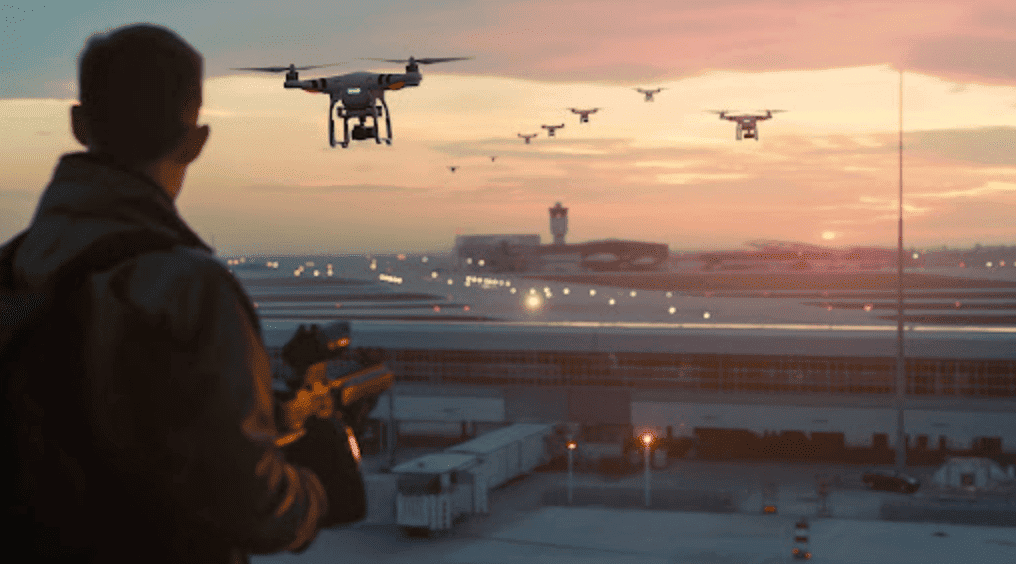Summary: Drone mitigation technology is an evolving landscape; prepare for broader mitigation authorities by focusing on early drone detection and pilot location to determine intent before taking action.
Legal constraints limit active counteractions for most organizations, so effective drone mitigation technology centers on law-compliant detection, pilot tracking, and informed response.
By combining detection systems (RF, radar, EO/IR, acoustic) with situational awareness dashboards, organizations can anticipate threats and apply appropriate mitigation steps without violating regulations. Prioritizing detection and response readies operations for unauthorized drone incursions while keeping within legal boundaries.
If you’re reading this, then you’re most likely in one of two camps when it comes to drone mitigation technology (taking a drone out of the sky).
Either you want to get your hands on this technology or you want absolutely nothing to do with it.
Drone Mitigation Technology is Commonly Referred to as Counter-Uncrewed Aircraft Systems (cUAS) Technology
While most cannot yet directly mitigate drones, the regulatory environment is shifting. State-level initiatives, such as Louisiana Governor Jeff Landry's signing into law a "sweeping new measure that authorizes state and local law enforcement to actively intercept and disable drones that pose credible threats to public safety," signal a coming change. This directive, while currently applicable only to law enforcement, highlights the growing momentum for broader mitigation authority and raises the question of how state and federal laws will align.
Many state, local, and private entities are eager for direct mitigation capabilities, and the regulatory environment is likely to adapt to meet these needs. While risks remain a consideration, the demand for effective countermeasures against drone threats is driving legislative changes.
Read on to learn more about kinetic and non-kinetic drone mitigation technology and how to prepare for a future with expanded mitigation capabilities.
A small number of Federal agencies can currently apply for legal waivers to destroy or take over drone control during national security interest level events or specific critical infrastructure locations. This capability is expected to become more widespread.
Kinetic Drone Mitigation Technology
Kinetic drone mitigation technology, or physical interdiction, while currently challenging due to drones being small, agile targets, is a critical tool for certain threats. Advances in technology will make these methods more effective and accessible.
Kinetic drone mitigation technology usually involves a ballistic resource being used to damage or destroy the drone, i.e., bullets, missiles, or other drones fired at the target drone. As the mitigation authority expands, strategies will evolve to minimize collateral damage and maximize effectiveness.
Another form of kinetic drone mitigation technology is capture. Many drone capture systems attempt to ensnare the drone’s propellers to disable but not destroy. These snares can be launched from a gun, suspended from a drone, or shot from a gun on a drone. The idea is to capture the drone for evidence and quickly disarm it as a threat. As mitigation becomes more prevalent, these capture methods will be refined for greater reliability and to address liability concerns.
Non-Kinetic Drone Mitigation Technology
While kinetic drone mitigation technology is currently reserved for a select few Federal agencies, and even those with authority can only exercise it in certain circumstances, non-kinetic mitigation is also advancing rapidly and will become more accessible.
Some non-kinetic drone mitigation technology techniques, while sharing similar collateral damage concerns with kinetic mitigation, are being developed with a focus on post-mitigation consequences.
The more extreme non-kinetic options, lasers and electromagnetic pulses (EMPs), are being tested and will become viable tools for authorized entities.
Jamming a drone’s control signal to send it back to its launch point is a less extreme option, and liability concerns are being addressed through evolving regulations and technology.
When someone jams or hacks into a drone signal to take control, that person, the remote pilot in command, assumes responsibility for the drone’s actions and consequences. This area is seeing significant legal and technological development to enable safe and responsible mitigation.
While currently prohibited in the US unless used by an authorized federal agency due to potential interference with emergency calls, networks, and first responder equipment, technologies that can jam a drone are under active development to allow for broader authorized use.
A Comprehensive Approach to Drone Mitigation Technology
As drone mitigation technology authorities expand, a multi-faceted approach will be crucial. The good news is that security teams and law enforcement will have more tools to combat increasing drone threats.
The safest, and arguably most effective way to address drone threats will continue to involve preventing them in the first place by finding the pilot before takeoff to determine intent.
Drone detection systems will continue to provide security teams and law enforcement with early warning of incoming drones and actionable information about the pilot’s location. This intelligence will be paramount in deciding the appropriate mitigation response.
Most drone pilots are not aware that they are a threat; many are simply clueless or careless and just need to be asked to land their drone. In these cases, locating the pilot allows for a non-escalatory resolution.
Those pilots with ill intent will likely not attempt an attack without practice or a dry run days or weeks in advance to determine the best attack plan and to gauge the security response.
When security forces don’t respond, the nefarious pilot may feel inspired and confident that their attack will succeed. When a drone detection system enables security teams to rapidly and consistently respond, a nefarious pilot who passes themselves off as clueless, harmless pilots may be discouraged and cancel their plans altogether.
Of course, due diligence and background checks on individuals will be an easy tool for law enforcement to evaluate who is who. When security personnel can find the pilot and mitigate the person, preventing the drone from launching, they won’t need to worry about kinetic/non-kinetic mitigation techniques unless a direct threat is immediately evident.
So, Drone Mitigation Technology...Should You or Shouldn't You?
The question is shifting. Soon, it will be about how you mitigate, not if. You will have expanded authorities, but the core strategy will remain: locate the pilot, determine intent, and then apply the appropriate level of mitigation.
Prepare for a future where drone mitigation technology is a more accessible and nuanced tool.
Drone Mitigation Technology FAQs
What is “drone mitigation technology”?
It encompasses methods and systems designed to interfere with, redirect, disable or capture an unwanted drone after it has been detected. This can include jamming, takeover/control, net capture, directed energy, and more. Because of legal restrictions, many organizations focus instead on detection + pilot locating as the mitigation path. (AeroDefense)
Why is mitigation more legally restricted than detection?
In the U.S., active interference with drones (e.g., jamming communications or navigation) is regulated under laws like the Wiretap Act, the Pen/Trap statute, and the FAA’s C-UAS/mitigation waiver regime. You can learn more about these laws and regulations here. Many non-federal entities lack the authority to perform active mitigation.
- Soft-kill / electronic: jamming RF links, spoofing GPS, cyber takeover.
- Hard-kill / kinetic: nets, intercept drones, missiles, directed-energy weapons.
- Many systems emphasize “pilot location” as the preferred mitigation path for non-authorised users. (arXiv)
What role does mitigation technology play within a broader counter-UAS strategy?
A best-practice model: detection → classification (friend vs foe) → pilot location → response/mitigation. Without reliable detection and identification first, mitigation becomes riskier and less justifiable.
- Safety: A fallen or diverted drone may injure people or damage property.
- Collateral effects: Jamming/spoofing may interfere with legitimate communications/navigation.
- Legal/regulatory exposure: Unauthorized use may result in penalties.
- Cost & complexity: Many full mitigation systems are expensive and complex compared to detection-only setups.
When should an organization consider implementing mitigation technology?
If the protected asset is very high value (e.g., major infrastructure, prisons, airports) and the legal/regulatory environment allows active mitigation. For many organizations, detection and pilot location remains the practical route for now. (AeroDefense).
What legal/regulatory steps must be considered before deploying mitigation?
- Verify your jurisdiction’s rules on jamming, takeover or destruction of drones.
- Some technologies require waivers (e.g., FAA 124n) for RF decoding or mitigation.
- Ensure your system does not decode private communications unless you are authorized.
- Document policies, approval chains, and operational protocols for usage and liability.


